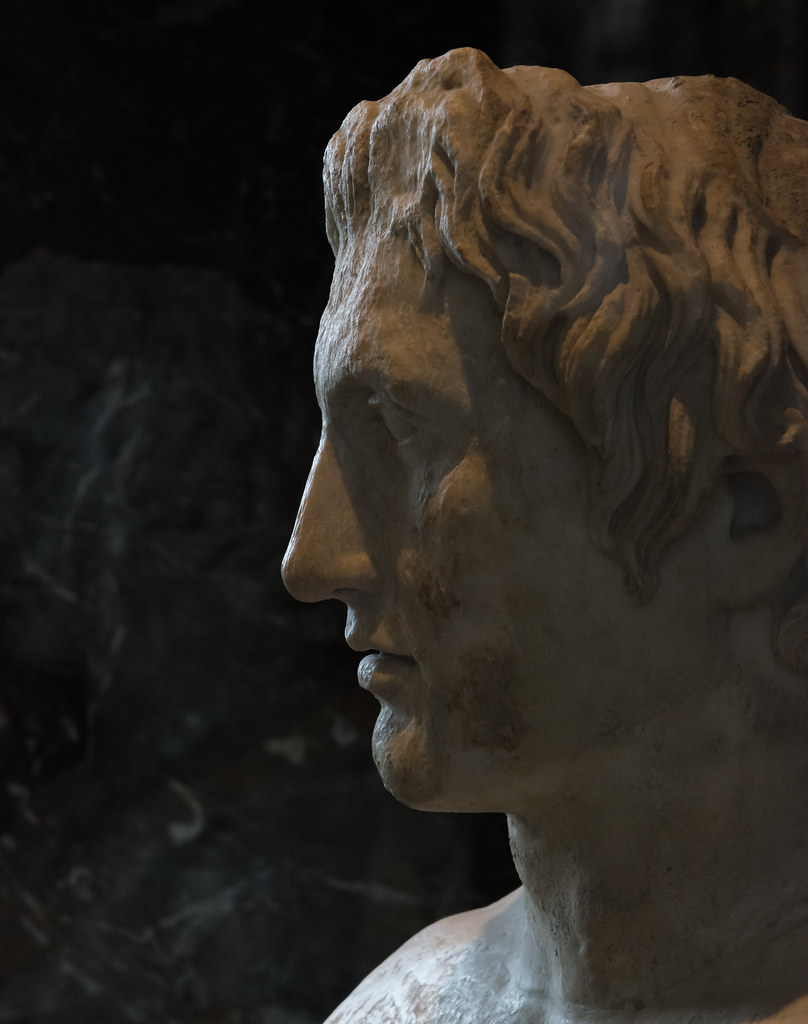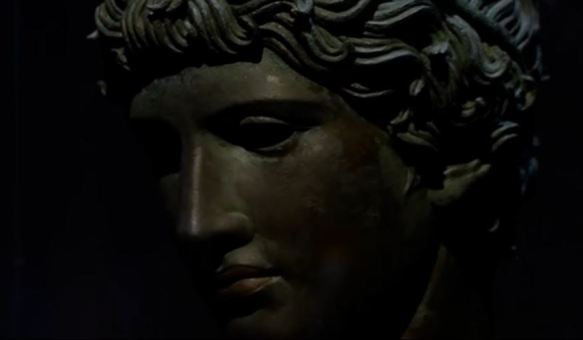L’Apoxyomène (en grec ancienἀποξυόμενος / apoxuómenos, de ἀποξὐω / apoxúô, « racler, gratter ») est un marbre d’après Lysippe, représentant, comme son nom l’indique, un athlète nu se raclant la peau avec un strigile. Il est conservé au musée Pio-Clementino (musées du Vatican) sous le numéro Inv. 1185.
Découverte
En 1849, dans le quartier romain du Trastevere, des ouvriers découvrent dans les ruines de ce qu’on croit alors être des thermes romains la statue d’un jeune homme nu se raclant avec un strigile[1]. Son premier commentateur, l’architecte et antiquaire Luigi Canina, l’identifie comme une copie du sculpteur grec Polyclète[2], mais dès l’année suivante, l’archéologue allemand August Braun[3] y reconnaît une copie d’un type en bronze de Lysippe (vers 330–320 av. J.-C.), que nous connaissons uniquement par une mention de Pline l’Ancien dans son Histoire naturelle : « [Lysippe] réalisa, comme nous l’avons dit, le plus grand nombre de statues de tous, avec un art très fécond, et parmi elles, un athlète en train de se nettoyer avec un strigile (destringens se)[4]. »
Le type est fameux dès l’Antiquité : toujours selon Pline, la statue est consacrée par le général Marcus Agrippa devant les thermes qui portent son nom. L’empereur Tibère, grand admirateur de la statue, la fait enlever et transporter dans sa chambre. « Il en résulta une telle fronde du peuple romain », raconte Pline, « qu’il réclama dans les clameurs du théâtre qu’on restituât l’Apoxyomène et que le prince, malgré son amour, le restitua[4]. »
Braun se fonde d’une part sur la pose de la statue, d’autre part sur les remarques de Pline sur le canon lysippéen, plus élancé que celui de Polyclète[5] : effectivement, la tête est plus petite par rapport au corps, plus fin — il faut toutefois remarquer qu’à l’époque, le Doryphore n’avait pas encore été reconnu comme tel[6]. Dans l’ensemble, les arguments avancés par Braun sont assez faibles[7] : d’abord, l’athlète au strigile est un type commun dans l’Antiquité. Ensuite, le canon élancé, bien qu’utilisé de manière intensive par Lysippe et son école, n’est pas spécifique à cet artiste : on le retrouve par exemple dans les combattants de la frise du Mausolée d’Halicarnasse[8]. Cependant, malgré des contestations, l’attribution à Lysippe est largement admise aujourd’hui[9].
La statue jouit d’une grande popularité dès sa découverte. Elle est restaurée par le sculpteur italien Pietro Tenerani qui complète les doigts de la main droite, le bout du nez, restitue le strigile disparu de la main gauche et cache le sexe de l’athlète par une feuille de vigne[10] — ces restaurations ont été supprimées récemment. De nombreux moulages en sont réalisés. Jacob Burckhardt la cite dans son Cicerone (guide de Rome) de 1865[11].
Description

Détail de la tête et des bras
La statue, réalisée en marbre du Pentélique est légèrement plus grande que nature : elle mesure 2,05 mètres[12]. Elle représente un jeune homme nu, debout, raclant la face postérieure de l’avant-bras droit à l’aide d’un strigile tenu de la main gauche. Il hoche légèrement la tête et regarde devant lui. Un tronc d’arbre sert d’étai à la jambe gauche ; un autre étai, aujourd’hui brisé, faisait supporter le poids du bras droit tendu sur la jambe droite.
La statue frappe d’abord par sa composition : elle n’est plus uniquement frontale, comme dans le Doryphore ou le Discobole. Le bras tendu à angle droit de l’athlète oblige le spectateur, s’il veut bien saisir le mouvement, à se déplacer sur les côtés. Elle se distingue également par l’emploi du contrapposto (« déhanché ») : le poids du corps repose sur la seule jambe gauche, la droite étant légèrement avancée et repliée. De ce fait, les hanches sont orientées vers la gauche, alors que les épaules sont tournées dans le sens inverse, suivant le mouvement du bras droit, créant ainsi un mouvement de torsion que le spectateur ne peut pleinement saisir qu’en reproduisant lui-même la pose. La musculature est rendue de manière moins marquée que chez Polyclète. Alors que le torse représente traditionnellement le morceau de bravoure du sculpteur, il est ici partiellement dissimulé par la position des bras.
La tête frappe par sa petite taille : elle représente un huitième du corps entier, contre un septième dans le canon polyclétéen. L’historienne de l’art Brunilde Sismondo Ridgway juge même l’effet « presque comique[13] ». Autre nouveauté, la tête est traitée comme un portrait : la chevelure est représentée en désordre, le front est marqué et les yeux, enfoncés. Pour R. R. R. Smith, ces caractéristiques rendent la tête plus vivante[14], mais Ridgway les considère comme des défauts attribuables au copiste, ou à une erreur de présentation de la statue : elle aurait pu être présentée sur une base surélevée[15].
Copies et variantes

L’Apoxyomène d’Éphèse

































